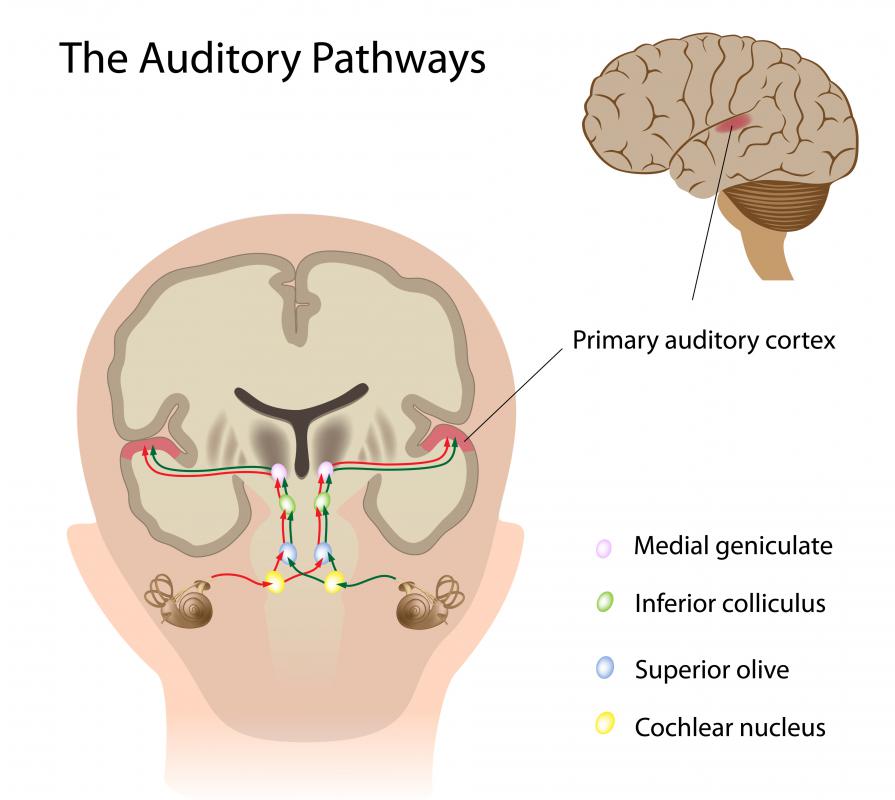At WiseGEEK, we're committed to delivering accurate, trustworthy information. Our expert-authored content is rigorously fact-checked and sourced from credible authorities. Discover how we uphold the highest standards in providing you with reliable knowledge.
What Are the Cochlear Nuclei?
The cochlear nuclei are structures in the brainstem where nerves from the spiral-shaped cochlea pass through. They serve as a gateway between the inner ear and the rest of the brain, allowing nerve impulses and sound information to be processed and transmitted to the brain’s major auditory centers. Divided into both the ventral and dorsal cochlear nucleus, they form a crucial section of the auditory pathway, and are also divided up into anterior and posterior sections. Both are located alongside the rear section of the brainstem, opposite from a motor nerve tract called the inferior peduncle.
Nerve fibers in the nuclei are organized into a complex system of spiral ganglion cells, which detect low frequency sounds, and axions from hair cells in the cochlea, which detect high frequency sounds. The cochlear nuclei have three major nerve projections that spread into the brain via the brain stem through the medulla. One is known as the ventral acoustic stria and passes through a brain structure known as the superior olivary complex. The dorsal acoustic stria, another projection, also traverses the medulla, along with the intermediate acoustic stria. These then pass through the pons, a brain structure that links both hemispheres, and into the nucleus of the lateral lemniscus.

All of the nerve fiber projections from the cochlear nuclei end in the inferior collicus, from which other projections spread out to the major auditory processing centers in the brain. Many of the nerve cells also pass through the core of the cochlea and end as hair cells that pick up each sound from the ears. There are also various other types of cells within the cochlear nuclei. Bushy cells, which feature small branches that create the appearance of bushes, and in the anterior ventral cochlear nucleus. They are primarily responsible for transmitting timing information between the main auditory nerve and other auditory processing areas.

Star-shaped cells called stellate cells fire electrical pulses at regular rates when a noise is detected. The rate of activity is determined by how strong the auditory input is, while octopus cells, located in the posterial ventral cochlear nucleus, respond to frequency. They fire at the beginning of any change in frequency, and are also important in transmitting information on the timing of sounds. These are also the highest-precision nerve cells of the brain in terms of temporal detection. Together, the cochlear nuclei and the rest of the auditory system process sound from the outside world along with its location, frequency, and timing.
AS FEATURED ON:
AS FEATURED ON:














Discussion Comments
@irontoenail - I wonder if that was a metaphor about the possibility of cancer from cell phones.
I'm sure the cells in the ear are quite vulnerable to it, I know they are vulnerable to damage from sound.
That's why often people who play in bands go deaf before they hit their 60's.
I have a musician friend who insists on wearing earmuffs whenever he plays or goes to see another band for just that reason.
Although I heard that cell phones have been tested with ear cells and brain cells and haven't actually harmed them so I suppose our cochlear nuclei are safe.
What they did harm was sperm cells, so if you are looking to have a kid someday I would be careful about where I put my cell phone after using it.
@croydon - That's an old idea and gets used in other ways as well. The cochlear nerve and the nerves in the eye are both targets since they are both so close to the brain.
And there are strange things that can be done through sound. People can be incapacitated by a loud enough sound, or one that is particularly shrill.
And supposedly Nicola Tesla managed to develop a sound which could make a person void their bowels, which he thought could be used in a battle. It would be formidable, but only if something as simple as earphones wouldn't block it.
That's the thing, once you cover up the ears, the cochlear nerves and nuclei aren't all that vulnerable anymore.
The most chilling example I ever read was when someone put a killing tone over the cellphone network, so everyone received a call at once, answered it and died. Considering how many people use cell phones that could take out a huge chunk of the population.
I've read quite a few novels and short stories where these nerves are exploited by evil governments or whoever in order to control the population. I think they use it in science fiction shows as well.
The theory goes that since the ear is so closely connected to the brain, there should be a way to make someone listen to a sound that will wipe their mind, or maybe make them into a slave or even kill them.
It's somewhat related to the idea of hypnosis, but often it's described as a transmission along the nerves into the brain.
I suppose in theory you might be able to figure out a way to get the brain cells to die if they are subjected to a tailored message, as there are chemical messages that can tell other cells in the body to die.
But I'm not sure how you could make that an audio message, as that's likely the only thing that would be transmitted along that kind of nerve.
Post your comments